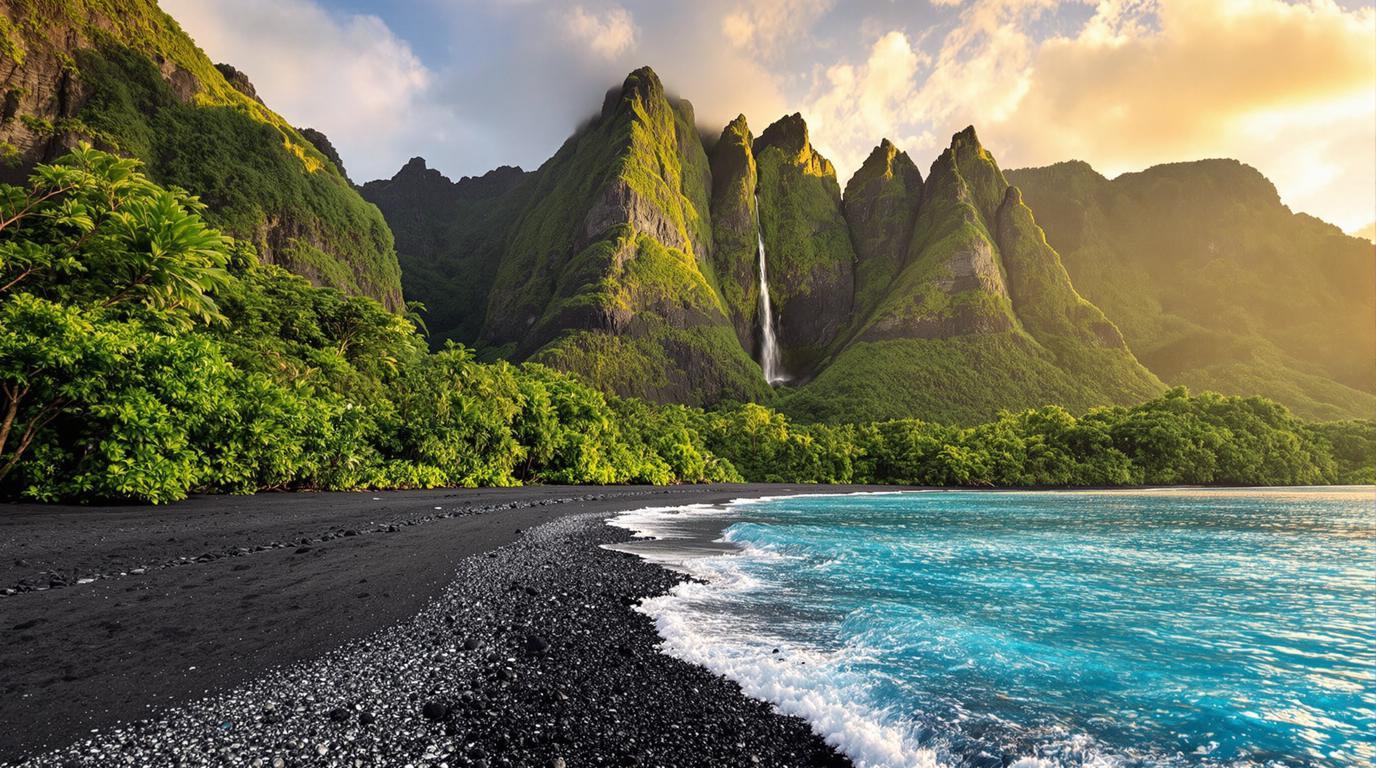Beyond the glossy brochures and typical tourist trails lies the real Tahiti – a volcanic paradise where black sand beaches meet turquoise lagoons and ancient Polynesian culture thrives beneath the shadow of towering peaks. Positioned at 17.6509° S, 149.4260° W in the heart of the South Pacific, this French Polynesian gem offers far more than just overwater bungalows and honeymoon hideaways.
Volcanic landscapes that defy expectation
Unlike its white-sand neighbors, Tahiti’s volcanic origins have blessed it with dramatic ebony shorelines. The island’s black sand beaches – particularly Plage Lafeyette and Taharuu Beach – create a striking visual contrast against the azure waters that surround them. These geological marvels remind visitors they’re standing on the remnants of ancient volcanic activity that birthed the entire archipelago.
“Our black sand tells stories that white sand cannot – it speaks of fire meeting water, of creation through destruction,” explains Maeva, a local cultural guide who leads tours through Tahiti’s interior valleys.
Papeete: more than just a gateway city
Many travelers use Papeete merely as a transit point, but Tahiti’s vibrant capital deserves proper exploration. The Papeete Market hums with activity, especially in early mornings when vendors arrange colorful displays of exotic fruits, handcrafted pareos, and Tahitian black pearls. For coffee enthusiasts, the market’s Bubble Wafflerie serves some of the best island-grown brews alongside delicious French-influenced pastries.
Secret waterfalls hidden in plain sight
Just beyond Papeete’s bustle lie some of Polynesia’s most spectacular cascades. The Faarumai Waterfalls plunge through emerald rainforests, yet remain surprisingly uncrowded even during peak tourist season. Meanwhile, the twin falls of Pape’Ana’ane and Vaihi create perfect natural swimming pools near Taravao – ideal spots for cooling off during the tropical heat.
The perfect time to visit: May through October
While Tahiti enjoys warm temperatures year-round, the period from May to October offers the driest conditions and most comfortable humidity levels. This optimal window coincides with whale watching season (July-November), when humpbacks migrate through these waters, often visible from shore or during respectful guided boat tours.
During these months, hiking the volcanic interior becomes especially rewarding. The famed Mount Aorai trail reveals panoramic views across the island and neighboring Moorea that simply can’t be matched during the wetter season.
Beyond the postcard: authentic cultural experiences
True travelers know that paradise islands often hide their best experiences away from tourist centers. In Tahiti’s rural communities, traditional va’a (outrigger canoe) sailing offers insights into ancient navigation techniques that once guided Polynesians across thousands of miles of open ocean.
“To understand Tahiti, you must understand how we see the ocean – not as something that separates islands, but as the great highway that connects them,” says Hiro, a master va’a builder from the island’s southern coast.
The grotto few travelers discover
The Grotto De Mara’a remains one of Tahiti’s best-kept secrets, much like hidden canyons that rival more famous destinations. This natural cave pool, surrounded by stalactites and fed by a gentle waterfall, offers a mystical swimming experience. Local legends claim the cave once sheltered ancient Polynesian royalty during tribal conflicts.
Culinary fusion that rivals global foodie destinations
Tahiti’s cuisine blends French technique with Polynesian ingredients in ways that rival famous food destinations worldwide. Don’t miss poisson cru (raw fish marinated in lime and coconut milk) or ahima’a (traditional underground oven cooking). The fusion creates flavors impossible to replicate elsewhere.
Beyond Tahiti: island-hopping opportunities
From Papeete’s harbor, the neighboring island of Moorea beckons just 25-45 minutes away by ferry. With climate conditions as perfect as Europe’s sunniest destinations, Moorea’s distinctive silhouette features dramatic volcanic spires that have inspired countless artists and photographers.
A legacy of inspiration
Like famous peaks that inspire cultural icons, Tahiti has shaped global impressions of paradise since European explorers first arrived. The island captivated painter Paul Gauguin, whose vibrant works immortalized Polynesian life and landscapes. Today, his legacy lives on at the Gauguin Museum, where visitors can walk through gardens similar to those that inspired his most famous works.
Tahiti doesn’t merely live up to its reputation – it transcends it. Beyond the expected luxury resorts lies a world of black sand mysteries, hidden grottoes, and cultural traditions that have survived centuries of outside influence. The real magic happens when you venture beyond the familiar, into the heart of this volcanic jewel of the South Pacific.
